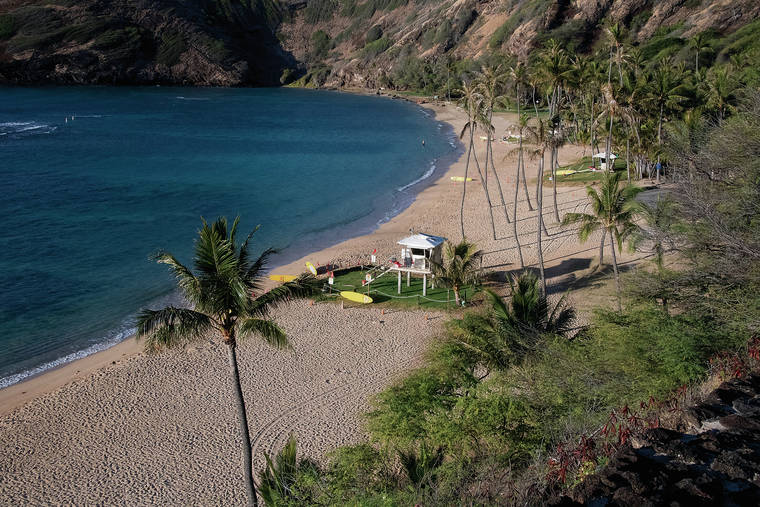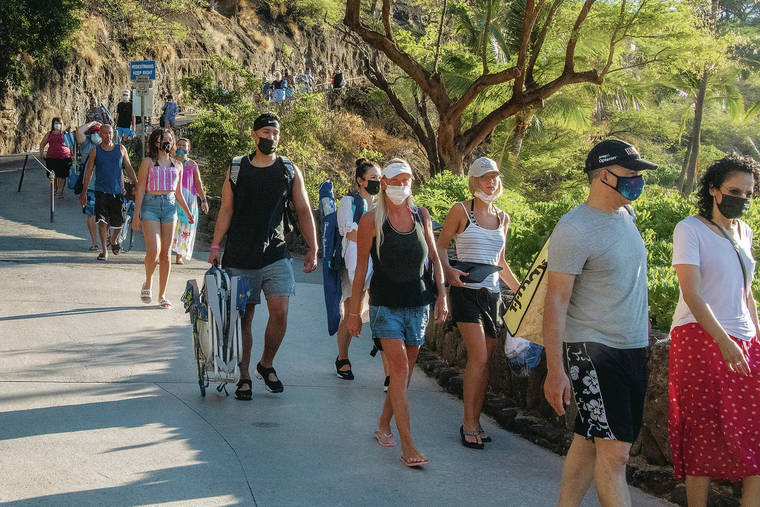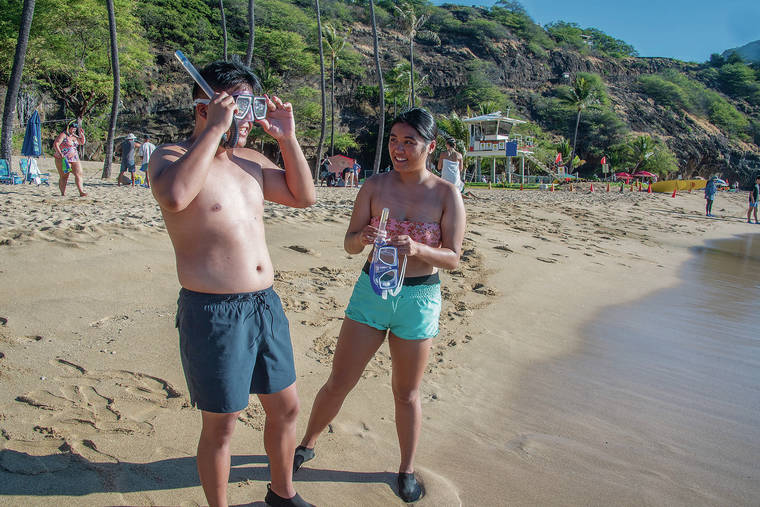In the first light of day, at 7 a.m., when Hanauma Bay Nature Preserve opens to the public, its great half moon of beach is empty, and the sea over its dappled reef is at peak clarity, before rising winds and waves, kicking swim fins and wading feet bring turbidity.
It’s also the time when Hawaii residents with state IDs enjoy the privilege of entering the vast, collapsed volcanic crater without a reservation until 8 a.m.
“It’s impossible to get a reservation online — they’re all gone in one minute — so I drove here by 6:30 a.m.,” said Annabella Taylor of Palolo Valley as she and her children, Zoe, Zen and Zarina, paused to overlook the bay’s turquoise waters as they walked down the hill Thursday morning.
Under a new reservation and visitor limitations system aiming to reduce stress on the bay’s coral reef ecosystem when it reopened in December, after 8-1/2 months’ closure due to COVID-19, the preserve currently receives about 1,400 visitors a day — half its former 3,000 visitors a day but almost twice the 720-780 daily visitors initially allowed at reopening, according to Nathan Serota, spokesman for the Honolulu Department of Parks and Recreation.
Meanwhile, a new study has found that population density and biomass of more than half the bay’s most common fish species increased during the closure but decreased after reopening at only 25% of the former visitor load.
This suggests “human avoidance behavior, even at 25% capacity of visitors, for these more sensitive species,” according to the “Hanauma Bay Biological Carrying Capacity Survey 20/21 Annual Report,” the third annual report conducted for DPR by the Coral Reef Ecology Lab of the Marine Biology Institute of the University of Hawaii at Manoa.
The study period ended two months after reopening and before the city began raising admission quotas. said lead author Sarah Severino.
“I find it interesting that seven of the 13 most abundant fish species in the bay showed an increase in density during closure, and after reopening really decreased in abundance, (showing) some response to an increase in visitors, even at 25% of normal visitor capacity prior to closure,” Severino said in a telephone interview.
“A lot of the study is broken down by species,” she noted, explaining that biomass refers to the size of the fish and the numbers of that particular fish, combined.
While many larger, common fish such as surgeonfish showed an increase both during the closure and after the reopening of the bay, the report said, many smaller species, such as butterflyfish, snappers and wrasses, decreased after the reopening.
“We’re thinking that these fishes are more sensitive to human interactions so may be modifying their behaviors,” Severino said, adding what she meant by sensitivity was “when you’re snorkelling around and fish respond to you (being) next to them and go into a hole, while other species don’t seem fazed at all.”
The seven species that increased with closure and decreased with reopening were palenose parrotfish (uhu), saddle wrasse (hinalea lauwili), belted wrasse (omaka), brighteye damselfish, blackspot sergeant (kupipi), white spotted toby and chubs (nenue).
Diversity of fish species also changed, Severino said, most notably in Keyhole, the most heavily snorkeled area of the bay.
While Keyhole significantly increased in mean fish density and biomass throughout the closure, it also experienced significant decreases in the number of species of fish (species diversity) and relative abundance of different species (species evenness), “which means less species in Keyhole,” she said.
Brown surgeonfish, convict tangs (manini) and chubs “have now infiltrated and become dominant species in Keyhole, and smaller ones are either hiding or have moved elsewhere (in the bay),” Severino said, adding, “Generally speaking, higher diversity is associated with a healthier reef.”
At the same time, she pointed out, an increase in diversity was seen in the Channel sector of the bay, which has more reef with crevices and holes, compared with Keyhole’s open, sand-bottom spaces.
Density of butterflyfish increased during the closure within all sectors, suggesting they may have come in from offshore or ventured out of shelter due to lack of visitors, the report said.
The marine biology team also conducted video recordings of fish behavior and found “when more snorkelers were in the water, they would flee sooner when approached, and when there were less snorkelers, they would let you approach closer before they would flee,” Severino said.
The bay’s water was 56% clearer during closure when compared with days at full capacity in 2018, “which was pretty significant,” Severino said, adding it remained 12.2% clearer after reopening at 25% capacity, “so that is something we can be excited about.”
There was 8.9% greater clarity during the closure than on Tuesdays, when the bay was closed to public, in 2018.
Since reopening, the bay is closed Mondays as well as Tuesdays.
On Thursday morning a reporter who last swam in the bay on its first reopening day Dec. 3 observed fewer, and different, fish species in Keyhole than the last time.
There were still large surgeonfish and large schools of manini, but compared with before, there were few turquoise parrotfish and red-and-green wrasses and none of the dinner plate-size butterflyfish that had previously swum close to humans without flinching.
Here and there a couple of pairs of small, four-spot butterflyfish swam unhurriedly beneath a swimmer without fleeing, but two threadfin butterflyfish were already deep in a hole, looking up, as a lone human approached; bird wrasses, with their long-nosed white faces, were prevalent before and now nowhere to be seen.
However, this was only what scientists call an anecdotal observation; in contrast, Ron Sanderson of Hawaii Kai, who has swum in the bay almost weekly for 50 years, said he saw “hundreds and hundreds of fish, the usual kine,” and was “so excited to be here because the online reservation system was impossible for me.”
While they hadn’t yet been in the water, first-time Hawaii visitors Zach Urgena, 28, and Mariel Cruz, 27, of New York City said they were astonished by the unique beauty of the bay and thought the $25 entry fee a person, recently raised from $12.50, was fair “because it’s to keep up the preserve,” Urgena said.
The cost was minimal compared with the “hundreds of dollars a person we pay to go to Disneyland,” said James Craig, a visitor from Pensacola, Fla.
Visitors also praised the video all entrants are required to view in the preserve’s theater before descending to the beach.
“The video was very informational, with the safety rules and what we can do to protect the reef, like not touching the animals or feeding them, and not leaving trash behind,” said Lizbeth Yerena, 22, of Los Angeles.
She added she would apply the knowledge “to maintain our sea life no matter where.”
Despite having to make an early morning drive to enter without a reservation, “I agree, to preserve the reef, they need to limit visitors,” said Waipahu resident Edie Ruiz, who arrived with her family at 5:50 a.m., adding she felt tourists should be welcome “so long as they respect the aina.”
As for how many tourists — and residents — the bay can tolerate, “I think there’s a happy medium, something we’ve been trying to find throughout our three-year capacity study,” Severino said.
FOR MORE INFORMATION
>> To read the study or make reservations, go to honolulu.gov/parks-hbay Opens in a new tab.






